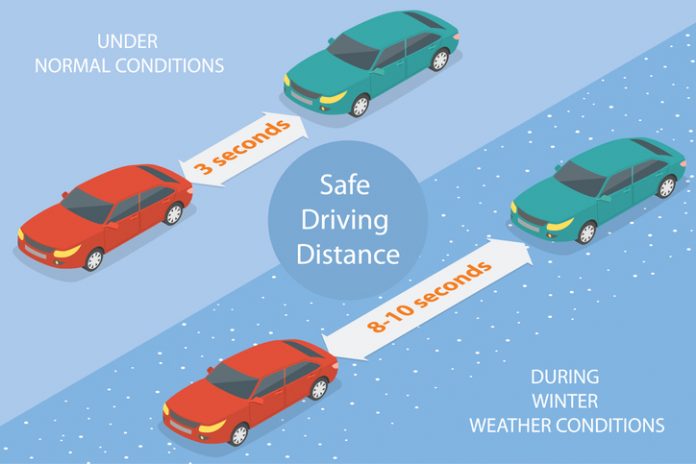Maintaining a safe driving distance is first and foremost in being a safe driver. Not only does it allow you the space needed to stop if needed, it also gives you time and space to avoid any unexpected issues that may crop up in the blink of an eye.
Too many times I have seen a personal vehicle make a panic stop at a traffic light, only to be hit from behind by a tractor trailer that claimed he couldn’t stop in time. Why couldn’t he stop in time? He was following too close. A good rule of thumb is to keep 6 or 7 seconds between yourself and the vehicle in front of you. To determine the time gap, use a bridge, telephone pole, or any stationary object, and when the vehicle in front of you passed the object, start counting “steamboats”. 1 steamboat, 2 steamboat, 3 steamboats, etc until you pass the same object. If you haven’t reached “6 steamboats”, you’re too close to the vehicle ahead of you. If you’re loaded particularly heavy, or the vehicle ahead of you arrears to driving erratically, increase the following distance by a few seconds, just to make sure you have enough room to stop. Of particular interest, during tourist season, be very aware of personal vehicles pulling camper trailers. Chances are, they have very limited experience pulling a trailer. In addition to their limited experience, they may not have the trailer loaded correctly, or their GVW might exceed the allowable GVW for their vehicle. Either of these conditions make them very unstable, and just the smallest issue could send them careening out of control, and you really don’t want to be following too close and join the mess. So do everyone a favour, and keep a safe distance.
Granted, maintaining a safe following distance on the highway is fairly easy, with all traffic moving at roughly the same speed. In city traffic, it can be a bit more difficult, especially with stop and go traffic, and people passing you, only to cut back into your lane to make a right turn. On the upside, you can stop a lot faster from city speed, but with that advantage comes the risk of someone behind you not being able to stop in time and running into the back of your trailer. While this a situation completely beyond your control, and would be classed a non-preventable accident, it still aways looks bad for your company (their name is prominently displayed on the side of the truck and trailer) and the industry in general. Your best bet is to anticipate people cutting you off, leave as big of a space ahead of you as possible to avoid having to make panic stops. Also, get in the habit of checking your mirrors very regularly, say every 2 seconds at most. By doing so, you’ll always have a complete picture of every vehicle close enough to your truck that could potentially cause an issue. When stopped at a traffic light, there are 2 very good reasons to leave plenty of space between yourself and the vehicle ahead of you. First off, if the vehicle in front of you breaks down, you want to have enough room to maneuver around them if need be. Secondly, and more importantly, if a truck approaching from the rear for whatever reason slams into the back of your truck, that space will absorb some of the kinetic energy from the impact. You may still be pushed into the vehicle in front of you, but the extra few feet will allow some of the energy to dissipate, and reduce the impact, possibly saving a few lives, and it makes you look more like a professional. Remember… Semi trucks don’t do “fender benders”. Again, checking your mirrors will tell you what’s coming up from behind, so you may want to add some extra braking pressure.
Another place where following too close can be extremely dangerous is railroad crossing. Never, under any circumstances, should you start to cross a rail crossing unless you know 100% that you can clear the crossing without stopping. I can’t stress this enough. NEVER EVER stop on a rail crossing! Too many people have been killed because for one reason or another, they had to stop on a rail crossing, and have been hit by a train. It should go without saying, but I’ll say it anyway. Always double and triple check for a train before starting to cross the tracks. On the highway especially, Don’t trust the warning lights and barrier arms at rail crossings. They are mechanical devices that can, and sometimes do fail. Turn down the stereo, open the window and listen. By law, the train must sound it’s horn as it approaches the crossing. If you hear the warning horn, be prepared to stop. Better to stop, then proceed slowly across the tracks, than to try and race the train. That’s one race you will never win.



















